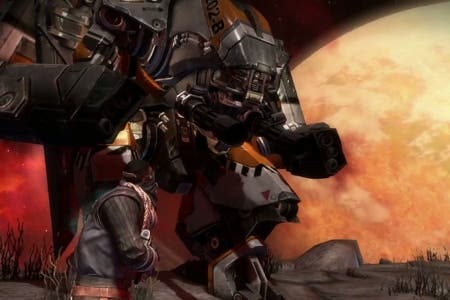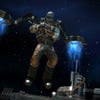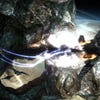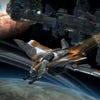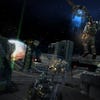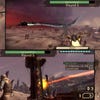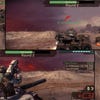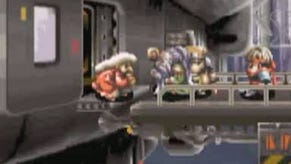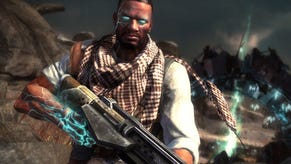Starhawk Review
Falcon hell.
In a genre where momentum is built in an avalanche of annual iterations and regular DLC updates, the five-year gap between Warhawk and Starhawk, its spiritual sci-fi successor, might as well be measured in decades. Consider this: when Warhawk was released, Modern Warfare was still an unknown quantity.
How to adapt to a landscape so irrevocably changed? Developer LightBox Interactive has opted for the softly-softly approach. Starhawk is still a large-scale third-person combat game with a heavy emphasis on vehicles, more Battlefront than Battlefield. What has changed is the context. As the name suggests, this game takes the science-fiction brush strokes of its predecessor and expands them to fill the canvas.
The setting is now the cosmic frontier, where a gold rush of sorts has kicked off over a new power source known as Rift Energy. There's a downside, however. Exposure to Rift Energy corrupts and mutates, and early prospectors have turned into Outcasts, mangled monstrosities that crave more energy and will fight to keep it for themselves.
With the two sides of the conflict duly established - "good guy" Rift miners versus "bad guy" Outcast mutants - you can dive straight into multiplayer or sample another new addition: the single-player campaign. Campaign is a rather grand word though for what is, essentially, a lengthy tutorial.
It's here that you're introduced to Build & Battle, Starhawk's biggest innovation over its ancestor. At all times, you're supported by an orbiting space platform that can drop structures onto the battlefield wherever you like, at the cost of some Rift Energy. Selection is via a simple-to-use pop-up radial menu, while placement and delivery are easy and quick enough to allow you to respond to situations in a timely fashion. With practice, you can even use the drops themselves as a weapon, landing a building on an enemy's head rather than wasting your ammo.
Walls and turrets can be dropped to quickly build defences, while watchtowers and supply drops add weapon-spawns such as long-distance railguns, rocket launchers and shotguns to the battlefield. Vehicle bays unload Star Wars-style speeder bikes, jetpacks, tanks and strangely familiar buggies with rear gun attachments. These are called Razorbacks, the Australian name for warthogs, so it's presumably a friendly nod in Bungie's direction rather than cynical imitation.
Then there are the Hawks, the toys everyone wants to play with. On the ground, they're powerful mechs, equipped with chainguns and an earth-shaking stomp. Hit the circle button and they transform, Starscream-style, into jet fighters. Both more fun and simpler to control than Battlefield's jets, the closest comparison, the Hawk's power is augmented by flying through colour-coded weapon pick-ups, unlocking guided missiles, torpedoes, bombs and other heavy-hitting weaponry.
It's to the credit of LightBox, made up largely of former developers from Warhawk studio Incognito, that the Hawks don't completely unbalance the game. Beam turrets on the ground make aerial dominance a tricky prospect, while the automatic lock-on of the rocket launcher weapon means that well-organised ground troops have a way of surviving encounters with the game's biggest stick.
That same careful balance sadly isn't evident elsewhere. The railgun is vastly overpowered and capable of insane accuracy over vast swathes of the game's 10 maps. Given the freedom of movement on offer, it's depressingly easy for a sniper to dominate a match by jetpacking up to some lofty perch and camping there for the duration.
Balancing is also an issue with the game modes, which fall into the expected multiplayer slots. There's straight Deathmatch, Team Deathmatch and Capture the Flag, plus Zones, a hold-and-control King of the Hill variant. The trouble is that the Build & Battle system clearly favours a bunker mentality, which means it sits awkwardly with some of these traditional styles of play.
CTF matches can become long, drawn-out affairs as teams naturally surround themselves with turrets and walls, with only a few hardy souls daring to attempt a grab on the other side. In all the matches I played, no-score draws were tiresomely common, with victories usually won by one point after a lucky sortie. Team Deathmatch suffers even more, as the hold-and-defend nature of the game's RTS elements is most at odds with a game style that demands constant fluid movement. Zones, on the other hand, benefits from the options made available by Build & Battle, and a 32-player match on one of the larger maps shows Starhawk at its best.
And, at its best, Starhawk can be very good indeed. Reviewing this sort of multiplayer game in the week of release is always a tricky task, closer to reviewing an MMO than the genre's fast-paced shooting would suggest. Players are still clearly getting to grips with the toolset, and finding the strategies that work best. Warhawk was well-supported with balancing patches and expansions, so there's every chance that Starhawk will evolve into something special over time, as players settle in and LightBox irons out the kinks.
Right now, though? It's good, but not much more than that. The maps are enjoyable without being particularly inspiring or memorable. The nods to RTS and tower defence are welcome, but ultimately don't do enough to change the core gameplay, tied as they are to game modes that have already been wrung dry. It doesn't take long to play with all the toys on offer, and few have strategic uses beyond the obvious. The weapon set is similarly predictable, and the overall aesthetic of the game is sadly anonymous, a pleasant but unremarkable stew of ideas and images pulled from Firefly, Riddick, Red Faction and dozens of other established sci-fi worlds.
Hopefully, having built such dependable foundations, LightBox is hard at work coming up with new game modes that will force players to use the Build & Battle idea in a way we haven't seen before, rather than simply using it as a slight twist on the familiar supply drop power-up system. What impressed in 2007 is no longer enough, and while Starhawk is a perfectly fine entry in the third-person multiplayer shooter genre, it's unlikely to inspire much long-term passion in its current state.
